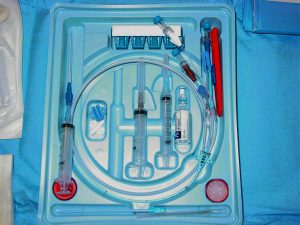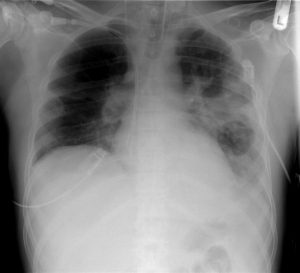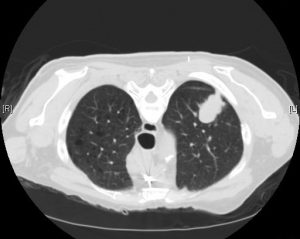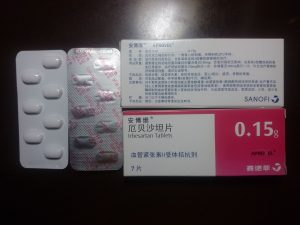
“Early Goal-Directed Therapy in the Treatment of Severe Sepsis and Septic Shock”
N Engl J Med. 2001 Nov 8;345(19):1368-77. [free full text]
—
Sepsis is common and, in its more severe manifestations, confers a high mortality risk. Fundamentally, sepsis is a global mismatch between oxygen demand and delivery. Around the time of this seminal study by Rivers et al., there was increasing recognition of the concept of the “golden hour” in sepsis management – “where definitive recognition and treatment provide maximal benefit in terms of outcome” (1368). Rivers and his team created a “bundle” of early sepsis interventions that targeted preload, afterload, and contractility, dubbed early goal-directed therapy (EGDT). They evaluated this bundle’s effect on mortality and end-organ dysfunction.
The “Rivers trial” randomized adults presenting to a single US academic center ED with ≥ 2 SIRS criteria and either SBP ≤ 90 after a crystalloid challenge of 20-30ml/kg over 30min or lactate > 4mmol/L to either treatment with the EGDT bundle or to the standard of care.
Intervention: early goal-directed therapy (EGDT)
-
-
- Received a central venous catheter with continuous central venous O2 saturation (ScvO2) measurement
- Treated according to EGDT protocol (see Figure 2, or below) in ED for at least six hours
- 500ml bolus of crystalloid q30min to achieve CVP 8-12mm
- Vasopressors to achieve MAP ≥ 65
- Vasodilators to achieve MAP ≤ 90
- If ScvO2 < 70%, transfuse RBCs to achieve Hct ≥ 30
- If, after CVP, MAP, and Hct were optimized as above and ScvO2 remained < 70%, dobutamine was added and uptitrated to achieve ScvO2 ≥ 70 or until max dose 20 μg/kg/min
- dobutamine was de-escalated if MAP < 65 or HR > 120
- Patients in whom hemodynamics could not be optimized were intubated and sedated, in order to decrease oxygen consumption
- Patients were transferred to inpatient ICU bed as soon as able, and upon transfer ScvO2 measurement was discontinued
- Inpatient team was blinded to treatment group assignment
-
The primary outcome was in-hospital mortality. Secondary endpoints included: resuscitation end points, organ-dysfunction scores, coagulation-related variables, administered treatments, and consumption of healthcare resources.
130 patients were randomized to EGDT, and 133 to standard therapy. There were no differences in baseline characteristics. There was no group difference in the prevalence of antibiotics given within the first 6 hours. Standard-therapy patients spent 6.3 ± 3.2 hours in the ED, whereas EGDT patients spent 8.0 ± 2.1 (p < 0.001).
In-hospital mortality was 46.5% in the standard-therapy group, and 30.5% in the EGDT group (p = 0.009, NNT 6.25). 28-day and 60-day mortalities were also improved in the EGDT group. See Table 3.
During the initial six hours of resuscitation, there was no significant group difference in mean heart rate or CVP. MAP was higher in the EGDT group (p < 0.001), but all patients in both groups reached a MAP ≥ 65. ScvO2 ≥ 70% was met by 60.2% of standard-therapy patients and 94.9% of EGDT patients (p < 0.001). A combination endpoint of achievement of CVP, MAP, and UOP (≥ 0.5cc/kg/hr) goals was met by 86.1% of standard-therapy patients and 99.2% of EGDT patients (p < 0.001). Standard-therapy patients had lower ScvO2 and greater base deficit, while lactate and pH values were similar in both groups.
During the period of 7 to 72 hours, the organ-dysfunction scores of APACHE II, SAPS II, and MODS were higher in the standard-therapy group (see Table 2). The prothrombin time, fibrin-split products concentration, and d-dimer concentrations were higher in the standard-therapy group, while PTT, fibrinogen concentration, and platelet counts were similar.
During the initial six hours, EGDT patients received significantly more fluids, pRBCs, and inotropic support than standard-therapy patients. Rates of vasopressor use and mechanical ventilation were similar. During the period of 7 to 72 hours, standard-therapy patients received more fluids, pRBCs, and vasopressors than the EGDT group, and they were more likely to be intubated and to have pulmonary-artery catheterization. Rates of inotrope use were similar. Overall, during the first 72 hrs, standard-therapy patients were more likely to receive vasopressors, be intubated, and undergo pulmonary-artery catheterization. EGDT patients were more likely to receive pRBC transfusion. There was no group difference in total volume of fluid administration or inotrope use. Regarding utilization, there were no group differences in mean duration of vasopressor therapy, mechanical ventilation, or length of stay. Among patients who survived to discharge, standard-therapy patients spent longer in the hospital than EGDT patients (18.4 ± 15.0 vs. 14.6 ± 14.5 days, respectively, p = 0.04).
In conclusion, early goal-directed therapy reduced in-hospital mortality in patients presenting to the ED with severe sepsis or septic shock when compared with usual care. In their discussion, the authors note that “when early therapy is not comprehensive, the progression to severe disease may be well under way at the time of admission to the intensive care unit” (1376).
The Rivers trial has been cited over 11,000 times. It has been widely discussed and dissected for decades. Most importantly, it helped catalyze a then-ongoing paradigm shift of what “usual care” in sepsis is. As noted by our own Drs. Sonti and Vinayak and in their Georgetown Critical Care Top 40: “Though we do not use the ‘Rivers protocol’ as written, concepts (timely resuscitation) have certainly infiltrated our ‘standard of care’ approach.” The Rivers trial evaluated the effect of a bundle (multiple interventions). It was a relatively complex protocol, and it has been recognized that the transfusion of blood to Hgb > 10 may have caused significant harm. In aggregate, the most critical elements of the modern initial resuscitation in sepsis are early administration of antibiotics (notably not protocolized by Rivers) within the first hour and the aggressive administration of IV fluids (now usually 30cc/kg of crystalloid within the first 3 hours of presentation).
More recently, there have been three large RCTs of EGDT versus usual care and/or protocols that used some of the EGDT targets: ProCESS (2014, USA), ARISE (2014, Australia), and ProMISe (2015, UK). In general terms, EGDT provided no mortality benefit compared to usual care. Prospectively, the authors of these three trials planned a meta-analysis – the 2017 PRISM study – which concluded that “EGDT did not result in better outcomes than usual care and was associated with higher hospitalization costs across a broad range of patient and hospital characteristics.” Despite patients in the Rivers trial being sicker than those of ProCESS/ARISE/ProMISe, it was not found in the subgroup analysis of PRISM that EGDT was more beneficial in sicker patients. Overall, the PRISM authors noted that “it remains possible that general advances in the provision of care for sepsis and septic shock, to the benefit of all patients, explain part or all of the difference in findings between the trial by Rivers et al. and the more recent trials.”
Further Reading/References:
1. Rivers trial @ Wiki Journal Club
2. Rivers trial @ 2 Minute Medicine
3. “Early Goal Directed Therapy in Septic Shock” @ Life in The Fast Lane
4. Georgetown Critical Care Top 40
5. “A randomized trial of protocol-based care for early septic shock” (ProCESS). NEJM 2014.
6. “Goal-directed resuscitation for patients with early septic shock” (ARISE). NEJM 2014.
7. “Trial of early, goal-directed resuscitation for septic shock” (ProMISe). NEJM 2015.
8. “Early, Goal-Directed Therapy for Septic Shock – A Patient-level Meta-Analysis” PRISM. NEJM 2017.
9. “Hour-1 Bundle,” Surviving Sepsis Campaign
10. UpToDate, “Evaluation and management of suspected sepsis and septic shock in adults”
Summary by Duncan F. Moore, MD
Image Credit: by Clinical_Cases, CC BY-SA 2.5 , via Wikimedia Commons


